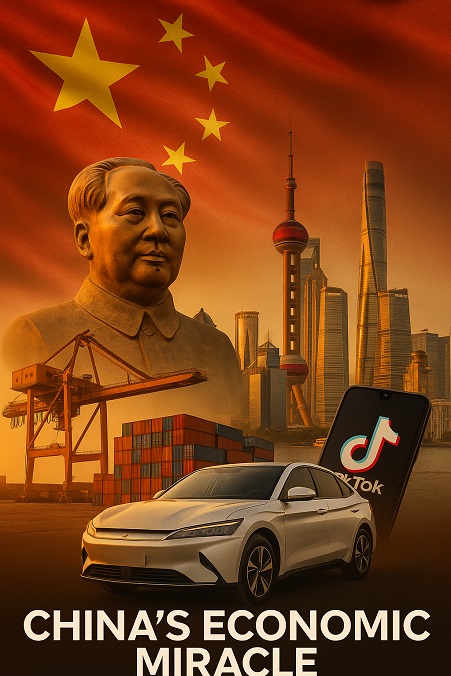Home ==> History of economics ==> Eden Economy Analysis
China's Economic Rise: A Journey from Humble Beginnings to Global Power
Imagine a nation that transformed itself from a patchwork of rural villages into a technological titan within a single generation. This is the story of modern China, a country that has rewritten the rules of global economics. As of June 2025, China stands as a beacon of innovation, its products shaping markets worldwide, from cutting-edge electronics to electric vehicles. Yet, this ascent was far from inevitable. What sparked this dramatic shift, and what challenges lie ahead? This article delves into the cultural, political, and technological forces that fueled China's rise, offering a fresh perspective on a phenomenon that continues to captivate the world.
The Spark of Change: A New Era Begins
The foundation of China’s economic miracle was laid in the late 1970s, following decades of isolation and hardship. After the tumultuous reign of Mao Zedong, which included the disastrous Great Leap Forward, a new leader emerged: Deng Xiaoping. His vision, introduced in 1978, shifted the country toward market-oriented reforms while retaining a strong central government. Unlike the abrupt economic overhauls seen elsewhere, China’s approach was gradual, experimenting with special economic zones like Shenzhen to attract foreign investment. This strategy paid off, turning sleepy fishing villages into bustling industrial hubs.
The Chinese Communist Party (CCP), with its 95 million members, played a pivotal role. Rather than abandoning its ideology, the CCP adapted, blending state control with capitalist incentives. This hybrid model fostered competition among provinces and encouraged private enterprise, setting the stage for unprecedented growth. By the 1990s, China was no longer just a producer of low-cost goods but a nation poised to lead in global innovation.
From Cheap Goods to Global Innovators
Two decades ago, "Made in China" was synonymous with inexpensive, often shoddy products—think flimsy toys or malfunctioning gadgets. Fast forward to 2025, and the label now represents some of the world’s most advanced technology. Companies like Huawei and Xiaomi have redefined the smartphone industry, while BYD has become a frontrunner in electric vehicles, outselling many Western competitors. This leap was driven by massive investments in research and development, with China allocating over 2.5% of its GDP to innovation—a figure that rivals top economies.
The shift also saw China take control of its supply chains. Once reliant on international middlemen to distribute goods, Chinese firms now dominate e-commerce platforms like Alibaba and logistics networks that deliver products directly to consumers globally. High tariffs and slow shipping, which once hampered exports, have been overcome with strategic infrastructure projects, including the Belt and Road Initiative, injecting billions into global trade routes.
In the automotive sector, the transformation is striking. Twenty years ago, Chinese buses were notorious for their poor suspension, making rides a jarring experience. Today, brands like NIO offer luxury electric cars with cutting-edge features, challenging Tesla’s dominance. This evolution reflects a broader trend: China’s focus on green technology has positioned it as a leader, with electric vehicle production soaring to 60% of the global market in 2024.
The digital realm tells a similar story. Platforms like TikTok, born from ByteDance, have revolutionized social media, captivating billions with short-form content. WeChat, meanwhile, has evolved into an all-in-one app for communication, shopping, and even government services, showcasing China’s ability to integrate technology into daily life.
Cultural Strengths and Demographic Dilemmas
At the heart of China’s success lies its workforce, shaped by a culture of diligence and respect rooted in Confucian values. The “996” work culture—12-hour days, six days a week—has become a symbol of this dedication, fueling rapid industrial growth. Yet, this model faces a demographic crisis. The one-child policy, enforced from 1979 to 2015, drastically reduced birth rates, with a particular impact on female infants due to cultural preferences for boys. Despite recent relaxations allowing up to three children, China’s population, currently at 1.41 billion, is projected to drop to 1.36 billion by 2030, straining its labor force.

Geopolitical Tensions and Regional Challenges
China’s geographical isolation, bordered by the towering Himalayas, has historically shaped its development. However, its most pressing geopolitical issue is Taiwan. Viewed by the CCP as an inseparable part of China, Taiwan operates as a self-governing democracy with U.S. backing. Tensions escalated after a 2022 visit by U.S. Speaker Nancy Pelosi, and as of mid-2025, military posturing continues, raising fears of conflict.
Surprisingly, China is also home to over 100 million Christians, outnumbering some Western nations’ totals. This growth, despite the CCP’s atheist stance, highlights a complex social landscape, with underground churches facing periodic crackdowns.
Global Rivalries and Historical Context
Recent years have seen friction with the United States, notably during Donald Trump’s presidency (2017–2021), when tariffs up to 25% were imposed on Chinese goods to curb trade imbalances and alleged intellectual property theft. While this slowed some exports, it also pushed China to bolster domestic production. Historically, China’s productivity shines through eras like the Han Dynasty (206 BCE–220 CE), known for silk and metallurgy, though periods of isolation, such as under the Ming Dynasty (1368–1644), hindered progress—lessons that inform its current global engagement.
The Road Ahead
As of June 25, 2025, China’s economic growth has slowed to 5% annually from double digits in the early 2000s, hampered by debt and geopolitical strains. Yet, with President Xi Jinping’s vision of a “socialist modernization” by 2049, the nation remains a formidable player. Its journey from humble beginnings to global power is a testament to adaptability—but also a reminder of the delicate balance between control and openness that will shape its future.
Keywords: China economic rise, Chinese innovation, tech industry China, cultural impact, demographic challenges, Taiwan tensions, Chinese Communist Party, trade disputes, electric vehicles, global influence
Political Economy of Eden The Shekel ⇒ Back to Home
